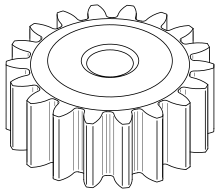Spur gear
Spur gears or straight-cut gears are the simplest type of gear. They consist of a cylinder or disk with teeth projecting radially. Though the teeth are not straight-sided (but usually of special form to achieve a constant drive ratio, mainly involute but less commonly cycloidal), the edge of each tooth is straight and aligned parallel to the axis of rotation. These gears mesh together correctly only if fitted to parallel shafts.[1] No axial thrust is created by the tooth loads. Spur gears are excellent at moderate speeds but tend to be noisy at high speeds.[2]

Spur gear teeth are manufactured by either involute profile or cycloidal profile. Most of the gears are manufactured by involute profile with 20° pressure angle. When two gears are in mesh at one instant there is a chance to mate involute portion with non-involute portion of mating gear. This phenomenon is known as "interference" and occurs when the number of teeth on the smaller of the two meshing gears is less than a required minimum. To avoid interference we can have undercutting, but this is not a suitable solution as undercutting leads to weakening of tooth at its base. In this situation Corrected gears are used. In corrected gears Cutter rack is shifted upwards or downwards.
The spur gears can be classified into two main categories: External and Internal. The gears with teeth cut outside of the cylinder are known as external gears. The gears with teeth cut on the internal side of the cylinder are known as internal gears. An external gear can mesh with an external gear or an internal gear. When two external gears mesh together they rotate in the opposite directions. An internal gear can only mesh with an external gear and the gears rotate in the same direction. Due to the close positioning of shafts internal gear assemblies are more compact then external gear assemblies.
PCD and MOD
In the case of Module (MOD) 4.0 spur gears:
- Normal spur gears (over 17 teeth) have a Pitch circle diameter (PCD) equal to MOD x Number of Teeth.[3]
- Corrected spur gears (under 17 teeth) have a PCD equal to MOD x Number of Teeth + MOD.
There are two types of corrected gears:
- S0 gearing (x1+x2=zero)
- S gearing (x1+x2 not equal to zero)
References
- "How Gears Work". howstuffworks.com. 16 November 2000. Retrieved 20 September 2018.
- Machinery's Handbook. New York: Industrial Press. 2012. pp. 2125. ISBN 978-0-8311-2900-2.
- http://www.metrication.com/engineering/gears.html